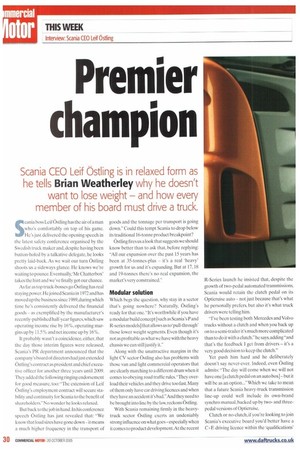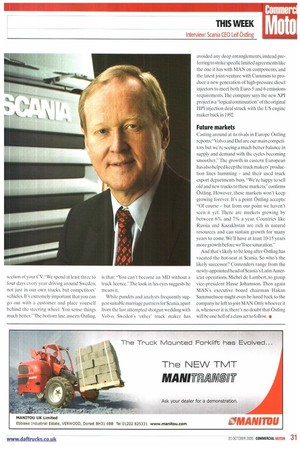Premier champion
Page 30

Page 31

If you've noticed an error in this article please click here to report it so we can fix it.
Scania CEO Leif Ostling is in relaxed form as he tells Brian Weatherley why he doesn't want to lose weight — and how every member of his board must drive a truck.
Scania boss Leif Ostling has the air of a man who's comfortably on top of his game. He's just delivered the opening speech in the latest safety conference organised by the Swedish truck maker and, despite having been button-holed by a talkative delegate, he looks pretty laid-back. As we wait our turn Ostling shoots us a sideways glance. He knows we're waiting to pounce. Eventually: Mr Chatterbox' takes the hint and we've finally got our chance.
As far as top truck-bosses go Ostling has real staying power. He joined Scania in 1972 and has moved up the business since 1989, during which time he's consistently delivered the financial goods as exemplified by the manufacturer's recently-published half-year figures, which saw operating income rise by 16%, operating margins up by 11.5% and net income up by 16%.
It probably wasn't a coincidence, either, that the day those interim figures were released, Scania's PR department announced that the company's board of directors had just extended Ostling's contract as president and chief executive officer for another three years until 2009. They added the following ringing endorsement for good measure, too: "The extension of Leif Ostling's employment contract will secure stability and continuity for Scania to the benefit of shareholdersNo wonder he looks relaxed.
But back to the job in hand. In his conference speech Ostling has just revealed that: "We know that load sizes have gone downit means a much higher frequency in the transport of goods and the tonnage per transport is going down." Could this tempt Scania to drop below its traditional 16-tonne product breakpoint?
Ostling fires us a look that suggests we should know better than to ask that, before replying: -All our expansion over the past 15 years has been at 35-tonnes-plus it's a real 'heavy' growth for us and it's expanding. But at 17,18 and 19-tonnes there's no real expansion, the market's very constrained."
Modular solution
Which begs the question, why stay in a sector that's going nowhere? Naturally, Ostling's ready for that one. "It's worthwhile if you have a modular build concept [such as Scania's P and R-series models] that allows us to `pull-through' those lower weight segments. Even though it's not as profitable as what we have with the heavy chassis we can still justify it.
Along with the unattractive margins in the light CV sector Ostling also has problems with those van and light commercial operators that are clearly marching to a different drum when it comes to obeying road traffic rules. "They overload their vehicles and they drive too fast. Many of them only have car driving licences and when they have an accident it's bad."And they need to be brought into line by the law, reckons Ostling.
With Scania remaining firmly in the heavytruck sector Ostling exerts an undeniably strong influence on what goesespecially when it comes to product developmen t.At the recent R-Series launch he insisted that, despite the growth of two-pedal automated transmissions, Scania would retain the clutch pedal on its Opticruise auto not just because that's what he personally prefers, but also it's what truck drivers were telling him.
"I've been testing both Mercedes and Volvo trucks without a clutch and when you back up on to a semi-trailer it's much more complicated than to do it with a clutch," he says, adding -and that's the feedback I get from drivers it's a very good decision to keep the clutch."
Yet push him hard and he deliberately doesn't say never-ever. Indeed, even Ostling admits: "The day will come when we will not have one [a clutch pedal on an auto box] but it will be as an option..." Which we take to mean that a future Scania heavy-truck transmission line-up could well include its own-brand synchro manual, backed up by twoand threepedal versions of Opticruise.
Clutch or no-clutch, if you're looking to join Scania's executive board you'd better have a C+E driving licence within the 'qualifications' section of your CV. 'We spend at least three to four days every year driving around Sweden, not just in our own trucks, but competitors' vehicles. It's extremely important that you can go out with a customer and place yourself behind the steering wheel. You sense things much better.' The bottom line, asserts Ostling, is that: "You can't become an MD without a truck licence." The look in his eyes suggests he means it.
While pundits and analysts frequently suggest suitable marriage partners for Scania, apart from the last attempted shotgun wedding with Volvo, Sweden's 'other' truck maker has avoided any deep entanglements, instead preferring to strike specific limited agreements like the one it has with MAN on components, and the latest joint-venture with Cummins to produce a new generation of high-pressure diesel injectors to meet both Euro-5 and 6 emissions requirements. The company says the new )(Pi project is a "logical continuation" of the original HP1 injection deal struck with the US engine maker back in 1992.
Future markets
Casting around at its rivals in Europe Ostling reports:"Volvo and Daf are our main competitors hut we're seeing a much better balance in supply and demand with the cycles becoming smoother." The growth in eastern European has also helped keep the truck makers' production lines humming — and their used truck export departments busy. "We're happy to sell old and new trucks to these markets," confirms Ostling. However, these markets won't keep growing forever. It's a point Ostling accepts: "Of course — but from our point we haven't seen it yet. There are markets growing by between 6% and 7% a year. Countries like Russia and Kazakhstan are rich in natural resources and can sustain growth for many years to come. We'll have at least 10-15 years more growth before we'll see saturation."
And that's likely to be long after Ostling has vacated the hot-seat at Scania. So who's the likely successor? Contenders range from the newly-appointed head of Scania's Latin American operations, Michel de Lambert, to group vice-president Hasse Johansson. Then again MAN's executive board chairman Hakan Sammuelsson might even be lured back to the company he left to join MAN. Only whoever it is, whenever it is, there's no doubt that Ostling will be one hell of a class act to follow. •










































































































































































































